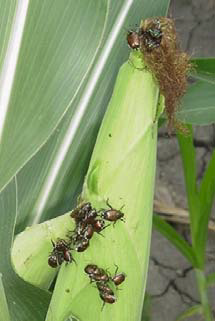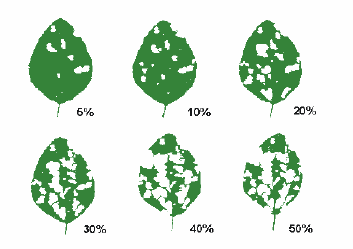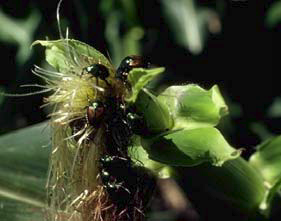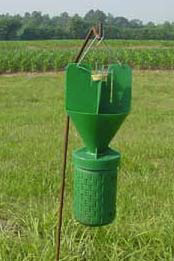Japanese Beetle
Popillia japonica Newman
Native to Japan, the Japanese beetle was first introduced into the United States in 1916. The Japanese beetle occurs in all states east ofthe Mississippi River, with sporadic infestations reported in California, Iowa, Missouri, and Nebraska. The host range of this insect is very large, over 300 species of plants. Adult Japanese beetles feed on and damage some field crops, ornamental plants, shrubs, and garden plants. The larvae feed on roots of many turf grasses, field crops, ornamental plants, and vegetables including Kentucky bluegrass, ryegrass, bentgrass, corn, soybeans, tomatoes, and strawberries. This insect is generally considered an infrequent pest of soybeans due to the defoliation it causes. Japanese beetle adults also may feed on silks of corn plants reducing pollination and kernel set.
Description
Japanese beetle adults, approximately ½ inch in length, are metallic green with bronze-colored elytra (wing covers). Just below the elytra, on each side of the abdomen are six tufts of white hair. Both the sexes of the adult beetles have the same markings, but the males are usually smaller in size than the females. Eggs of the Japanese beetle vary in color from translucent to creamy white. Under highmagnification, tiny hexagonal punctures appear on the surface ofthe egg. Newly laid eggs are about 1/20 to 1/16 inch in diameter and ellipsoidal. As the eggs mature, they double in size, and take amore spherical shape. The larvae, or grubs, are about 1 inch inlength. The C-shaped grubs are creamy white with a brown head capsule. The immatures possess chewing mouthparts and have three pair of legs onthe thorax. The grubs are similar in appearance to other commonly found white grubs in the soil. Japanese beetle grubs can be identified by the V-shaped pattern of bristles on the raster. Pupae of Japanese beetles resemble the adult, except the legs, antennae, and wings areclosely folded into the body. As the pupal stage nears its end, the color of the pupa changes from a pale tan color to metallic green.

Life Cycle
Japanese beetles have a univoltine life cycle(one generation per year). They over winter as third in star larvae in the soil below the frost line. As soil temperatures warm in the spring, the larvae move closer to the soil's urface. They complete pupation and emergence begins in late May and early June. Peak emergence generally occurs 4 to 5 weeks after initial emergence. At that time, emerging beetles crawl or fly in search of host plants to feed and mate. Japanese beetles are naturally gregarious and tend to aggregate on host plants.
In mid-June, female beetles begin laying eggs in the soil. During the day, females will leave host plants, burrow into the soil, and lay between 1 and 4 eggs at a time. Mating and egg laying occurs throughout the entire life of the adult beetle which lasts from 30 to 60 days. a female may lay between 40 and 60 eggs during her life time. Depending on temperature, eggs hatch in about 10 to 14 days after they are laid. Larvae complete three in stars, while feeding on plant roots and decaying plant material.
Injury

Silk clipping on corn
Japanese beetle adults feed on more than 300 plant varieties. These insects exhibit a preference for some plants over others, thus damage to preferred plants is more severe. The beetles defoliate host plants, chewing tissue between the leaf veins, leaving a lace-like skeleton. They generally feed on foliage on the upper and outermost parts of the plant, working their way down the plant. Severely injured leaves turn brown and drop off the plant.
In corn, Japanese beetles cause injury both as grubs and adults.As grubs, they feed on root hairs, interfering with the uptake of water and nutrients. Injury caused by grubs will often go unnoticed until plant growth and

Defoliation on soybeans
development is affected. Nutrient deficiencies such as phosphorous may cause the purpling of corn stems. Heavily infested fields may have significantly reduced plant stands and may result in replanting. Japanese beetles feed on corn silks as adults, interfering with the pollination process. Extensive silk clipping may lead to incomplete ear fill and yield loss.
In soybeans, grubs also feed on the root hairs of seedling plants, though the injury is generally not of economic importance. The main threat of Japanese beetle adults in soybeans is the defoliation of soybean plants. Much of the defoliation of soybeans occursduring the reproductive stages of plant development. Feeding on flowers may interfere with pollination. Japanese beetles are part of a complex of insects that feed on soybeans. Individually, Japanese beetles may not cause sufficient injury to warrant treatment, but when combined with the feeding of other soybean defoliators, treatment may be needed occasionally.

Esitmating soybean defoliation
Scouting Procedure
In soybeans: It's important to scout flowering soybean fields for the presence of the Japanese beetle and the extent of defoliation. Estimate the number of beetles per foot of row and examine the plants to determine if any blooms are being destroyed. Estimate the percent defoliation in at least five different areas of the field. Insecticidal treatments should be considered when defoliation reaches 30% before bloom and 20% before bloom & pod fill.
In corn: Estimate the number of beetles per ear and the examine ears todetermine the extent of silk clipping. Be sure to look at a representative portion of the field. Populations of Japanese beetles are usually clumped together as a result of the pheromones they emit that cause them to aggregate. There are usually clumps of Japanese beetles near field edges, probably due to beetles moving from areas of emergence to host plants within the area. If sampling only occurs near areas where these clumps of Japanese beetles occur, densities across the field may be over estimated.Even though densities may appear to be extremely high, the average density of beetles may be below levels of economic concern. An insecticidal treatment is should be considered during the silking period if:
- there are 3 or more beetles per ear,
- silks have been clipped to less than ½ inch, AND
- pollination is less than 50% complete
*Note* When scouting for Japanese beetles, be cautious of falseJapanese beetles. False Japanese beetles are usually found in areas with sandy soils. False Japanese beetle rarely cause economic injury to crops, but it is important to correctly identify them. About the same size as Japanese beetles, false Japanese beetles are similar in appearance to Japanese beetles, but are more dull in color whereas Japanese beetles are shiny and more brightly colored. False Japanese beetles do not have the characteristic arrangement of the six white tufts along their abdomen as do Japanese beetles. Control of false Japanese beetles is not recommended in agricultural crops in Illinois.
Management

Japanese beetles aggregating on corn silks
Management of the Japanese beetle in corn and soybeans is very challenging. Both the adults and larvae have the potential to cause injury to these crops in different ways. It is difficult to predict where grubs will be present from year to year. Heavily infested areas with grubs do not guarantee the crop planted in that same area will suffer severe injury due to adult feeding. Eventhough adults tend to aggregate, theyare very mobile. Therefore, controlling one life stage will notnecessarily eliminate problems with the other.
Management of adult beetles focuses on the prevention of defoliation in soybeans and silk clipping in corn from exceeding economic levels. Scouting entire fields is essential in determining the extent of injury of a crop. Japanese beetle injury to either corn or soybeans will add to other stresses that the crop is experiencing (such as moisture stress). Consider adjusting the economic thresholds accordingly. A reduction in economic thresholds for insect injury when plants are suffering from other stresses may be warranted. The potential for lower yields usually results in an increase of economic thresholds. There are many insecticides labeled for use oncorn and soybeans to control Japanese beetles. When making a decision on regarding the use of an insecticide, take into account several factors: the density of Japanese beetles, amount of injury (silk clipping in corn, defoliation in soybeans), level of crop stress, yield potential, and cost of control.

Pheromone bucket trap
Japanese beetle traps are most useful for detecting Japanese beetle emergence and monitoring population fluctuations. Since the trapping of adult beetles involves the use of pheromones, traps generally attract beetles from surrounding areas. Their use as a tool for control is not recommended.
Predicting future infestations of Japanese beetles would most likely be frustrating and often futile. However, one can generally anticipate economic densities of Japanese beetles after mild winters, followed by early planting (the first 2 weeks of April). Infestations also are the greatest in east-central Illinois where there is a history of repeated problems with this insect.
More Information
Japanese Beetle Watch, North Central Integrated Pest Management Center.
(http://www.pmcenters.org/northcentral/jbeetle/index.htm)
Japanese Beetle. Ohio State University Extension Fact Sheet.
(http://ohioline.osu.edu/hyg-fact/2000/2504.html)
Japanese Beetle in Kentucky Soybean, University of Kentucky.
(http://www.uky.edu/Agriculture/Entomology/entfacts/fldcrops/ef143.htm)
NAPIS Cooperative Agricultural Pest Survey Program, Japanese Beetle.
(http://www.ceris.purdue.edu/napis/pests/jb/)